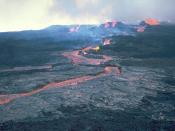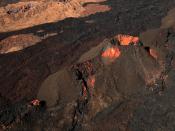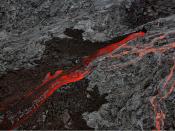When coming in by air on the final approach to the airport on the Island of Oahu in Hawaii, the crystal clear blue waters lead to a breathtaking view of the extinct volcano named "Diamond Head". A week later, similar waters escorted me to the "Big Island" called Hawaii, from which the Islands collectively derive their name. Hawaii is the home of five volcanoes, and only one, Kilauea, was still raging. The perfect timing of my arrival allowed me to step within inches of the newly erupted, yet barely moving lava. Walking on the lava from Kilauea, the twenty thousand foot high, ever-active, and simply incredible volcano was one of the most memorable events in my life.
To give some background, Kilauea is currently the most active volcano in the world. Though seemingly an attachment to Mauna Loa, the largest volcano on Earth, the above sea level section is actually a large independent volcano, being just over 4,000 feet high and 700 square miles at the base.
In that area exists the Caldera, which is a four square mile, 700-foot high crater where the original eruptions occurred. Now, only the Hale'mau'mau, a thirteen hundred foot high, 3,000 foot in diameter crater, produces eruptions.
What separates Kilauea from any other volcano is its remarkable eruption history. Starting on January 3, 1983, the lava has yet to stop flowing. An amazing 500 acres of land has been added to the Island since 1995, and in the process several buildings have been destroyed. Luckily, when I came in August of 2002, Kilauea was still putting on a spectacular show.
Being with my uncle, we took a hike of approximately two miles across geologically infantile-aged lava to the actual site of the lava flow. Accidentally, we veered off the lightly...



Comment
Great information on the geographic elements of the Hawaiian Islands. Paper was writtern well, and kept the reader interested in the subject.
2 out of 2 people found this comment useful.